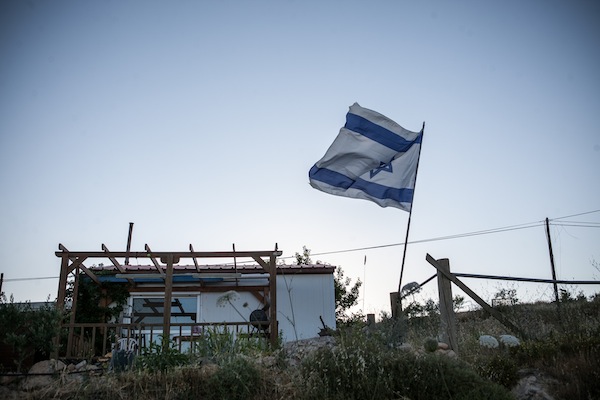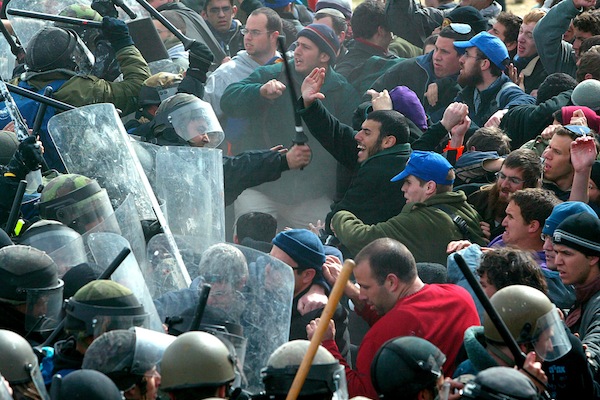The state will ask the High Court to, once again, delay the demolition of Amona. Here are a few myths surrounding one of the most stubborn outposts in the West Bank.
By Yesh Din, written by Yossi Gurvitz

In recent months the residents of Amona and right-wing politicians have been waging a campaign designed to prevent the evacuation of this unauthorized outpost and to continue seizing the lands that belong to the residents of the Palestinian villages Silwad, Taybeh and Ein Yabrud. However, the High Court of Justice ordered the outpost be evacuated by the end of December 2016. It is crucial for the public to know the truth, especially in light of the vast misinformation on the subject. Here are a few of the most baseless arguments we’ve heard in the media recently (followed by our responses).
“There is no landowner who is a concrete petitioner claiming ownership of the lands of Amona.” (Chairman of the Constitution, Law and Justice Committee, MK Nissan Smolianski, August 3, 2016).
The land on which Amona stands on and the surrounding area is regulated private Palestinian lands, registered in the Tabu. Ten Palestinians petitioned the High Court of Justice (you can see their names listed in the petition) to demand the outpost be evacuated and to allow them to return to their land. Their names are displayed on the petition, they gave interviews to the media and the High Court ruled in their favor. Does it get any more concrete than that?
“Amona’s land was purchased from the Palestinian owners.”
Settlers first made this argument in the 1990s, but never provided evidence. The Civil Administration rejected the claim definitively in 2004 and issued demolition orders in Amona. Later on, residents of Amona presented the High Court with documents that claim they have proof of land purchase. The police determined that some of the documents were forged. The High Court determined that the illegal construction could not be authorized, even if small portions of the land were in fact purchased.
In addition to the purchase claim, the founders of the outpost tried to argue from the beginning that it was built on land that had a military seizure order on it. The High Court ruled in the past that a military seizure order could not be used to establish settlements. When Amona was first established, the Attorney General in the West Bank determined that a military seizure order was never implemented and is therefore nullified.
“Arabs never lived there, it was a bare rocky mountain.” (Sara Ziv, Amona resident, Makor Rishon, January 22, 2016).
The argument that the Amona settlers arrived to an abandoned piece of land is repeated over and over. This claim was already refuted when aerial photos were presented by the Civil Administration during a civil suit filed by the petitioners against the state. The photographs prove that the Palestinian landowners cultivated the land until the outpost was built, and that it was only after the army barred their access, and due to fear of the settlers, that they stopped working the land. It is important to remember that a civil proceeding forced the government to compensate the Palestinian landowners for the protracted infringement on their rights as a result of the fact that the outpost had not yet been evacuated.
“None of us thought or knew that this was private property.” (Avichai Boaron, head of the Amona public campaign, Yedioth Ahronoth July 15, 2016).
This is an odd argument, considering that the Civil Administration issued stop-work orders for every structure in Amona as of 1996, noting these structures were built on private property. The High Court also determined in its 2005 ruling that nine permanent structures in the outpost were built on private Palestinian land.
“When I got here 10 years ago, the understanding was that there was a problem only with nine homes, and after they were demolished, we thought the rest was legitimate. I am a rational person. I wouldn’t build a home and raise kids in a place classified as illegal.” (Uri Goldberg, Amona resident, Yedioth Ahronoth July 15, 2016).
All the homes in Amona were issued demolition orders and a decade earlier it was made clear this was construction on private land. Amona doesn’t meet any of the demands for the establishment of a settlement in the West Bank and its homes were never granted building permits. This, as a matter of fact, is the situation in all the outposts, such that it is clear to every rational person that Amona is illegal and the claim they didn’t know is disingenuous. In any event, this is irrelevant since the government undertook to evacuate the entire outpost by 2011 since the construction there is illegal, and the High Court ruled at the end of 2014 that it must be evacuated within two years.

Even before the High Court ruling, two official state reports – the Spiegel Report and the Sasson Report – indicated that the outpost is located on private Palestinian land.
“A community is situated under its grapes and figs for years and suddenly someone undermines ownership of the land.” (Infrastructure, Energy and Water Minister Yuval Steinitz, Arutz Sheva July 20, 2016).
Another mistake articulated by those who object to the evacuation of Amona is that the Palestinian landowners “suddenly remembered” 20 years later that they own the land. The truth is of course different. A short time after the first caravans were positioned in Amona the Palestinian landowners demanded they be evacuated. The Israeli DCO promised them then that the homes were being treated as illegal but that the evacuation process takes time. In 1998, when the residents of Silwad requested to hold prayers on the hilltop ridge on which the outpost was built, they were told that “any illegal activity will be handled by authorized entities.”
“Behind every petition is a left-wing organization with an agenda.” (Avichai Boaron, head of the Amona public campaign and a resident, Arutz Sheva, July 17, 2016).
Behind every High Court petition are Palestinian landowners who employ the help of human rights organizations to safeguard their rights. Behind the unauthorized construction of outposts is an entire mechanism dedicated to expelling Palestinians from their land, with the help if local councils, the Amana organization, the IDF, the Yesha Council, the Settlement Division, politicians and government ministries. Did someone say agenda?

“This is destruction for destruction’s sake. After they destroy this place this Arab will go back to the land?” (head of Yeshivot Bnei Akiva, Rabbi Haim Drukman, Arutz Sheva May 18, 2016).
Ibrahim Ja’ama, a resident of Ein Yabrud and one of the landowners who petitioned for the evacuation of Amona, said recently in an interview to Walla News!: “First of all, I want to take my children to see our land. They were young when it happened, and they have forgotten. If you are not in touch with something you love, you may forget it. I want to renew their love and connection to our land.” Since Amona was established, its landowners have not been able to return, as the IDF prohibits them. We hope that with the evacuation of the outpost, they will be able to return to their land and use it as they see fit.
The State funded Amona.
No argument here. The Ministry of Housing, as reported in the Sasson Report (p. 152), transferred funds to the Binyamin Regional Council in order to finance the construction of Amona’s infrastructure, while fully aware that this is illegal. At the same time, the Civil Administration operated to evacuate the outpost. It is worth examining whether there is a way to take steps against the government entities that transferred funds illegally to those who invaded private land. However this should have no bearing on the decision to evacuate the outpost.
“The vast majority of Amona’s land is defined as absentee property, in other words, land without an identifiable owners. Furthermore, the names listed on most of the plots were not recognized after the Six-Day War.” (Yehuda Yifrach, legal correspondent, Makor Rishon, and a former resident of Amona, Makor Rishon July 4, 2016).
As aforementioned, all the land on which the Amona outpost is built is regulated private land, registered in Tabu. Another attempt by the Amona settlers to instruct the Civil Administration to declare the land absentee property and hand them over to their children was rejected by the Jerusalem Magistrate’s Court in 2016.
To put it simply: This is not absentee property. Some of the actual landowners petitioned the High Court to demand the outpost be removed from their land. The intention to declare plots of land adjacent to the outpost’s structures as abandoned property also turned out to be baseless, since these lands have flesh and blood landowners.
Written by Yossi Gurvitz in his capacity as a blogger for Yesh Din, Volunteers for Human Rights. A version of this post was first published on Yesh Din’s blog.
